One of the most beloved and hunted species in the world are the dolphins, on this occasion we will talk about these marine animals, their characteristics, a little about echolocation, how they reproduce, at what time they prefer to do so, how dolphins are born and everything related to their birth, what they feed on and at the end you will learn some curiosities about these beautiful, very intelligent and collaborative animals.
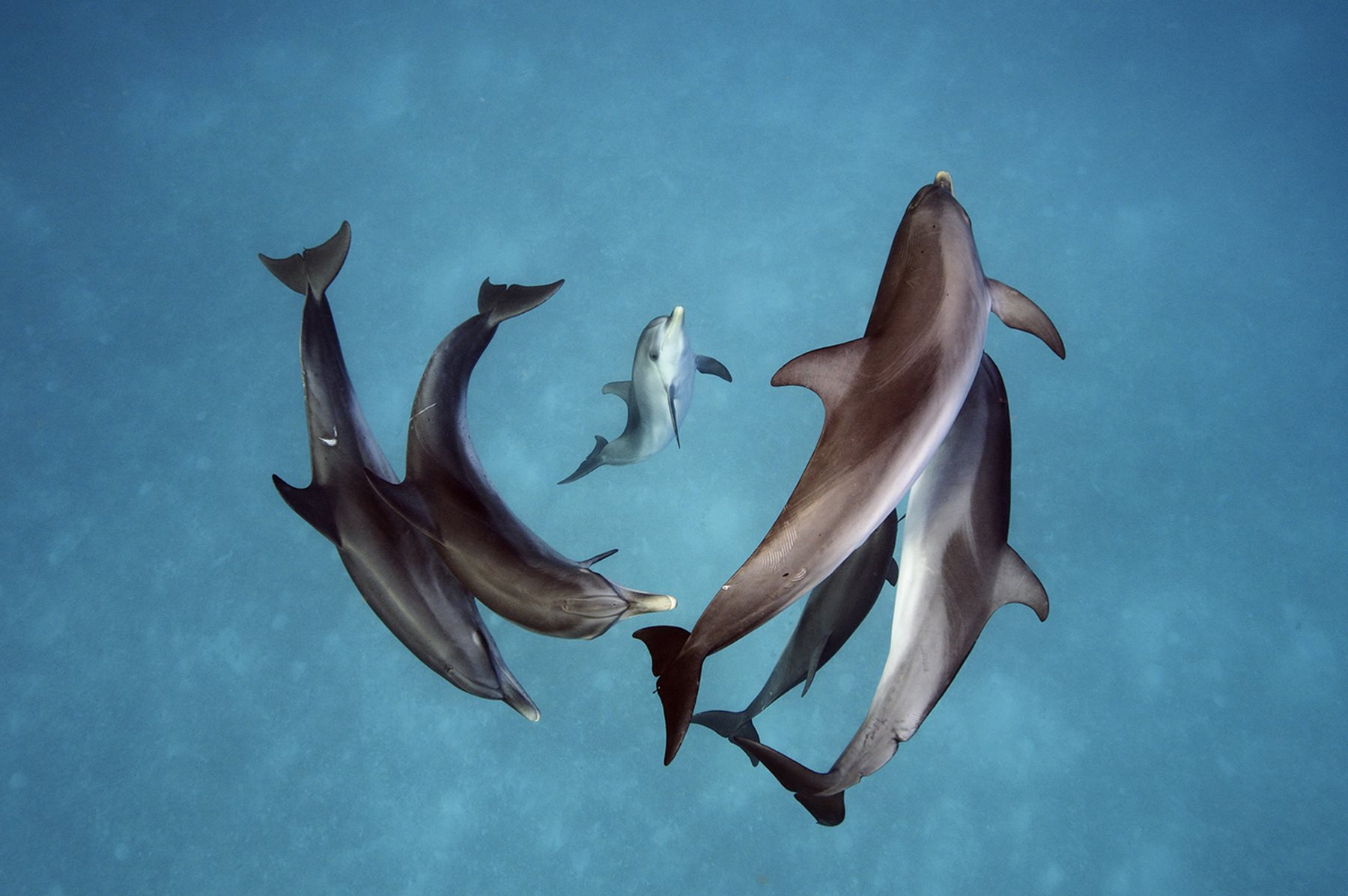
What are Dolphins?
Delphinidae is the dolphin scientific name which is also called oceanic dolphin, considered as odontocete cetaceans. The infraorder of cetaceans includes all those mammals with placentas that live in the sea, all of this family have spindle-shaped bodies that allow them to be more hydrodynamic than other fish.
In turn, cetaceans belong to the order Artiodactyla, suborder whippormopha and the class of dolphins is mammalia. As for the classification of "odontocetes", this comes from the parvorder within cetaceans that identifies those that have teeth instead of baleen.
It is possible to see them on the coasts and in those places where they are normally seen there is interaction with humans, their relationship with people is quite close. Taking into account that dolphins have a presence in legends and mythologies, such as the Greek mythology where it was indicated that these animals were previously men and were converted to dolphins by Dionysus.
These marine animals use sounds to communicate with others, as well as dance and jumps for the same purposes and to navigate or hunt. Something important about dolphins and other mammals is that they use echolocation to communicate and locate.
Echolocation is the way in which dolphins can learn about the environment in which they are and places further away from them through the sounds they emit with this ability. They also interpret the echo produced by the objects that are around them.
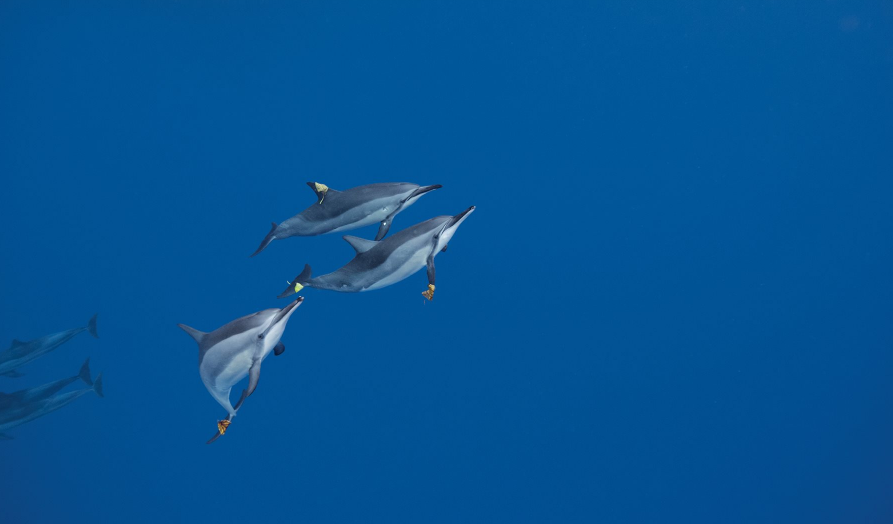
Dolphins and whales were found to be able to use echolocation after bats were found to do so by emitting sounds and receiving echoes. In essence, this is the emission of a sound that bounces off an object and produces an echo that reaches the source from which the original sound was emitted (the dolphin, the bat, the whale, etc.)
Even so, this echo does not reach all animals with the same intensity, neither at the same time nor with the same frequency, taking into account that there are various objects around them and that bounce the sound emitted. The echo difference is seen because the animals that echolocate have two ears and this is what allows them to recreate in their minds the place where the objects are, the distance between them and the same, among other things.
La intelligence of this species is something characteristic of it and that for years has served to represent this incredible marine family, they have been studied and the development of their culture has been discovered, an example of this is the discovery of Flemming Nic in Australia, who made a investigative work that indicates that dolphins transmitted knowledge from mothers to daughters about the use of tools to feed.
Even so, conflicts and aggressiveness are present, although it is not as noticeable as in other species such as El Tigre, Of course this happens due to competition for females or conflicts between males for other things.
Among some of the activities that the dolphins have been led to do, we have the show, where they are trained to perform acrobatics, aerial pirouettes, movements with their tails, among other things in water parks and zoos. This is due to the skills they have to jump and the intelligence they show.

Dolphins have also been seen carrying out military activities such as mine detection and marine protection of army installations, as well as raiding. This is observed in a program that has existed since the 60s in the United States and not only involves dolphins, but also false killer whales, killer whales, pilot whales, among other marine animals.
Perhaps the most curious activity is cooperative fishing with humans: in the city of Laguna - Brazil, people make a line of fishermen and canoes near the coast, once the dolphins make an appearance by chasing the fish to the men is that the fishing begins.
They not only collaborate with the fishing of humans, but also with that of other animals such as penguins and shearwaters, this after cornering their prey so that they can be eaten in turns.
Features
- They can measure from two to nine meters long but on average they have a length of 3,5 meters
- They live in groups of more than 1000 dolphins because they are quite social animals, this allows them to create strong bonds with other individuals that is evidenced in the care and accompaniment of some dolphins to others who are injured.
- They can make various sounds with the nasal air sacs below the blowhole, such as whistles, clicks (with echolocation), and bursts of impulsive sounds. The clicks they emit can be up to 1000 every second.
- In freedom they can swim with a speed of over 30 kilometers per hour, a sign of their great speed. When swimming they also come to the surface to breathe two or three times every minute.
- The bottlenose dolphin is the animal that has one of the largest brains in animalia.
- A dolphin can live between 30 and 60 years, it all depends on the species of dolphin, striped dolphins live longer than bottlenose or bottlenose dolphins.
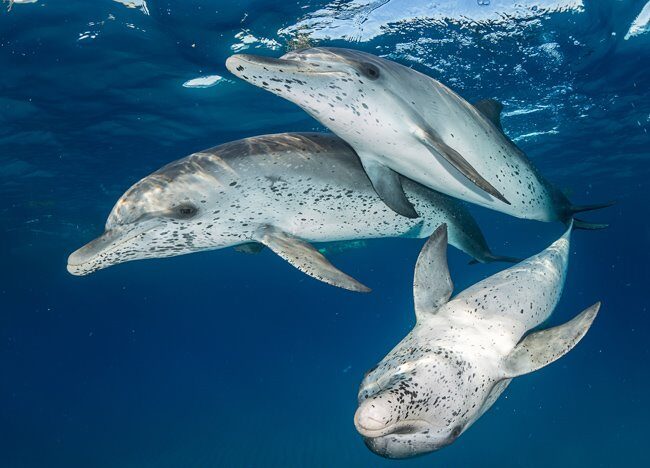
reproduction of dolphins
Before knowing how dolphins are born to answer the question about How do dolphins reproduce? First of all, it should be known that these animals are not very fertile, the females do not have as many offspring, although they have sexual intercourse many times. This means that although they are very libidinous they are not so fertile and added to that they can be fished or they can suffer problems due to contamination, which does not allow them to increase considerably.mind your number.
They have sex not only to reproduce, that is why they are libidinous, perform various sexual positions just for pleasure, just like humans and primates, an example of the latter may perhaps be the Mountain gorilla. However, they do this when they reach sexual maturity, which is when they are 5 or 7 years old.
The males reach maturity before the females and they are the ones that are more active than them. As for mating, dolphins first carry out a courtship, the males approach after they carry out the courtship which is based on various forms of swimming around the female, this could seem like underwater games but it is the mating routine.
After she accepts it to mate, she lets the male bring his penis and testicles closer to the vaginal opening that they have, then they bring their bellies closer and perform fertilization after the sexual act, then the process that explains how dolphins are born will begin.
When two dolphins of different species that are at least of the same gender are going to mate, they are called hybridization, An example of this are the whales, which are a mixture between the false killer whale or the black killer whale and the bottlenose dolphin, hence they have 66 teeth (an intermediate number between the number of teeth of their parents). Hybrids are generally sterile, but balfins are fertile.
breeding season
They perform the sexual act many times regardless of the time of year, however to reproduce they prefer summer or spring (warm seasons). They also do it in temperate zones of the sea. The reproduction of these dolphins is sexual just like that of humans, that is, through copulation and fertilization they reproduce.
Females cannot be said to have a mating season, although they are less sexually active than males. In any case, they can ovulate between two and seven times annually, this, like the lifespan, depends on the species within the family of dolphins. Even so, its time for reproduction is usually between the spring and autumn seasons.
Gestation period
When fertilization takes place, gestation begins, which lasts twelve months for the baby dolphin inside its mother's womb, although it can be longer depending on the species. During this period, mothers eat more food for the fetus to grow without problems and that their breast milk is ideal to feed it during the first months.
The mothers of the species of bottlenose dolphins usually travel to warmer areas with a temperate climate before giving birth and that is where they do it, now you will know how dolphins are born.
Nacimiento
Once the gestation period is over, you will see how the dolphins are born: first sticking out the tail and then coming out completely, the umbilical cord of these animals is not maintained but is broken when the fetus comes out. At the moment they are born they rise to the surface to breathe.
How long do they take to hatch? This can take 40 minutes or an hour, but it can also take much longer (three hours). In all this time there is a terrible danger because the females lose a lot of blood, which calls the predators that can hunt her and eat her and her young.
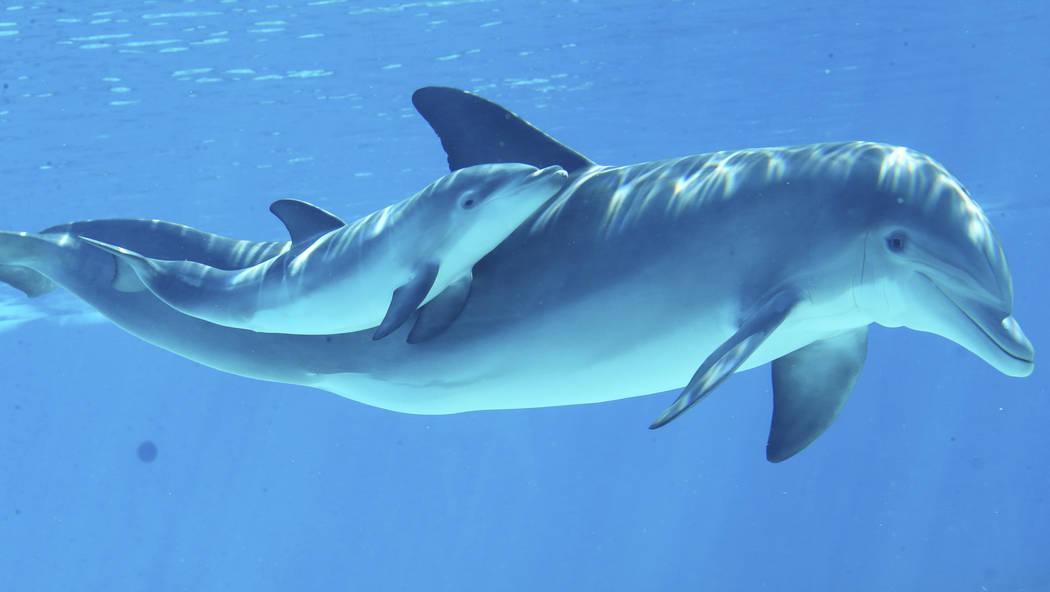
The most interesting thing about this is how other dolphins are at this moment of birth, they assist her and after guarding how the dolphins are born, the others surround the female as a form of protection. Similarly, other females approach at the time of birth to help the mother during childbirth.
This is another sign of their intelligence and their sociable behavior, which leads them to help each other when they are in groups. Dolphins are very peaceful animals and quite playful not only with humans but with other dolphins, of any species. Of course, they are tenacious against predators and can be quite aggressive to defend themselves and other dolphins in the group.
To find out how many babies can dolphins have researchers have observed this species for years, to determine that they only have one offspring every two or three years. It is very unlikely that they have two fetuses inside them, they can still lose a baby, they can be born dead, etc.
Newborns can measure a meter or a meter and a half long, however, and can weigh between 30 and 40 kilograms. It all depends on the species, because an adult dolphin can also measure 40 kilograms.
Dwelling time of a dolphin with its mother
In the feeding of the dolphins we will notice that they receive breast milk, this means that they must be with their mother during the first months in order to survive. This is called the lactation period and it lasts twelve months or twice as long after everything we have seen about how dolphins are born. Even so, dolphins can stay between three or six years with their mother even if the lactation period ends.
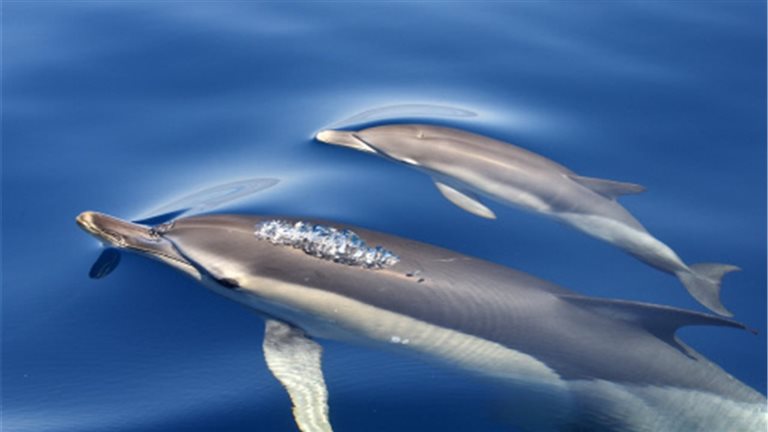
During these years there is a learning process that allows them to learn to swim more quickly, to interact with other dolphins, to get food for themselves and to hunt their prey with the different techniques they usually use. During this time it is not the case that baby dolphins always stay with their mothers, sometimes they can leave them alone so that they learn to be individually with other dolphins.
The purpose is to teach them to be independent and that they can live without having their mother by their side, although the dolphins are always found in groups, each one of them can hunt individually. The situations in which dolphins carry out collective activities are also very special, it is because of this behavior that they are exceptional and very intelligent animals.
Food
Being mammals, baby dolphins feed on breast milk for the first months of their existence until they are one year old, then they begin to eat fish or squid. Then, depending on their age, they have various foods such as fish weighing 5 kilos and below, octopuses, molluscs or marine animals that are similar in size to those mentioned.
Their hunting methods range from chasing using their speed, to using echolocation to discover prey hidden in the sand, they also tend to corner prey on the coasts, taking advantage of when waves come to hunt them. A form of hunting is also seen in Florida where bottlenose dolphins surrounded mullets with mud curtains to capture them.
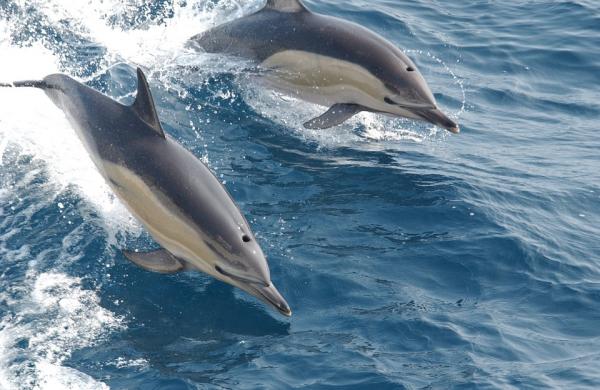
Another way to hunt is by cornering groups of fish, but this is done when they are in packs or by stalking prey and knocking it off balance by hitting ice banks, the methods vary depending on the prey they are going to hunt. Some scientists have drawn conclusions about the use of echolocation and the emission of sounds to kill small prey through acoustic shocks.
It is important to highlight that little information is handled about reproduction and how dolphins are born, in the wild it has not been possible to acquire much information and that is why everything that is known about them corresponds to their life time in water parks, in captivity and in pools for study.
In addition to that, many things vary depending on the species in question, as we have seen throughout this post. Bottlenose dolphins are the ones that have been studied the most, that does not mean that they are the best known, because killer whales, dolphins and other animals are just as common. The little that has been seen has shown that there are differences in their behavior when they are in captivity and when they are in the wild.
In any case, it is known that technological advances allow much more aquatic territory to be covered, more species can be known, more data can be obtained on how dolphins are born and more information can be obtained about their behavior in freedom, which of course is much more natural. than what has been seen in studies of captive dolphins.
Curiosities
We have seen how dolphins are born and how they reproduce, now we will list some interesting facts for you to learn a little more about them.
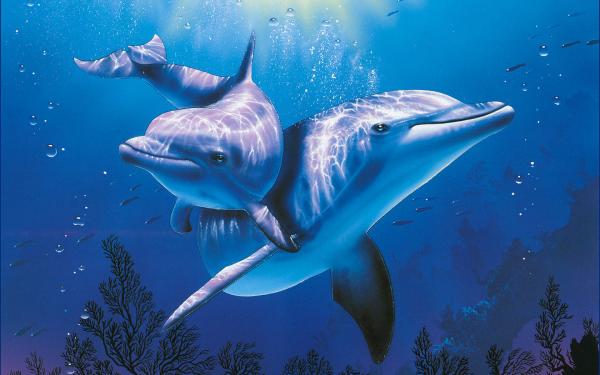
8 curious facts about dolphins
- These animals sleep even though they are in a space in constant movement due to sea currents, even so they do so by disconnecting half of their brain in order to rest and at the same time stay alert to defend themselves from predators such as Tiburones or threats that surround them.
- They are seen on the coasts because that is where they prefer to swim, they like shallow waters in places with tropical and temperate climates.
- La hydroplaning It is carried out by this species every year to get away from the seasons in which the climate makes the waters cold, during this migration they can swim at a speed greater than 54 kilometers per hour.
- Echolocation allows them to determine from 30 meters whether an object is made of metal, plastic or wood, as well as they can perceive the sound impulses that other dolphins receive to know what they "see" with their echolocation.
- There are more than two thousand captive dolphins in water parks and it is estimated that there are approximately nine million in the wild, knowing that their family includes many species.
- Along with their ability to echolocate, they enjoy a highly developed sense of hearing, differentiating sounds from various materials.
- Their intelligence becomes evident when they are trained to innovate with new tricks, when they interact with humans, when their behavior is observed, when they see how dolphins are born, when they study the number of sounds they produce and the complex system they seem to have created. for communicating.
- We indicated earlier that they "turn off" half of their brain, it is curious that when sleeping they also keep one eye open and one closed.
Family Delphinidae
Not only common dolphins are part of this family, this species has several members within it and is divided into gender, being able to differentiate one dolphin from another by its physical characteristics. These are the members of this family:
- common pilot whale
- short-finned pilot whale
- Coastal (of the Sotalia family)
- Narrow-beaked acrobat dolphin
- Long-beaked stunt dolphin
- Antarctic dolphin
- Heinsohn's beluga dolphin
- Irrawaddy river beluga dolphin
- burrunan dolphin
- coastal common dolphin
- oceanic common dolphin
- crossed dolphin
- atlantic dolphin
- melon-headed dolphin
- Fraser's dolphin
- Heaviside's Dolphin
- Hector's Dolphin
- white beaked dolphin
- Risso's dolphin
- Indo-Pacific Dolphin
- pacific dolphin
- Tropical spotted or saddled dolphin
- Atlantic humpback dolphin
- Striped dolphin
- Atlantic spotted dolphin
- tropical spotted dolphin
- southern finless dolphin
- Bottlenose dolphin
- dark dolphin
- Hong Kong pink dolphin
- northern finless dolphin
- false killer whale
- common killer whale
- pygmy killer whale
- Chilean dolphin
- tonina overa
- tucuxi
